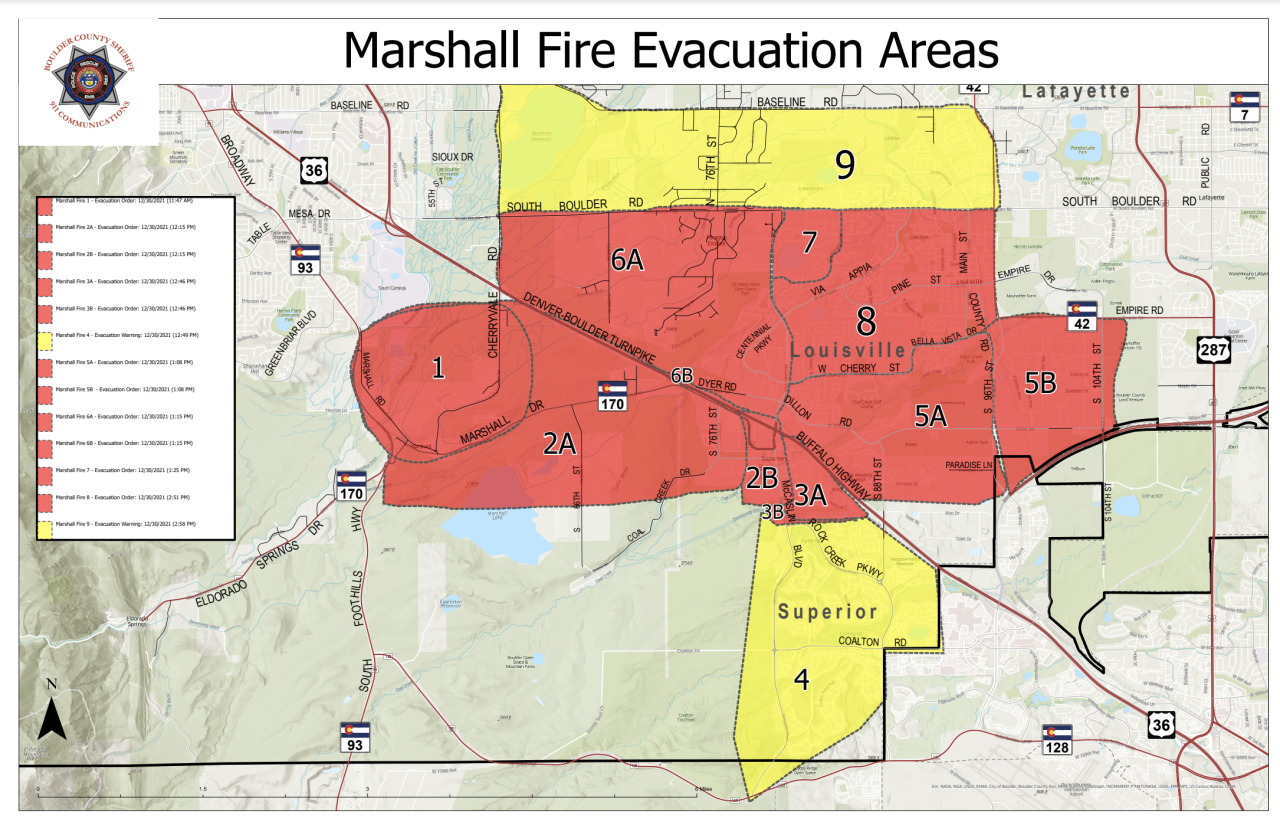LOUISVILLE, Colo. — As families who lost everything in the Marshall Fire continue to plan their next steps, questions are now surfacing about the emergency response and how responding crews handled an emergency of such a large scale.
At Tuesday's Louisville City Council meeting, Louisville Fire Chief John Wilson said the emergency response needs to improve.
“You have hired me to protect you and your property… and I feel like I have let you down,” Wilson said. "I can’t express how much we can get better for the next time, and I know that’s not going to relieve the pain that the citizens are going through. I promise that we’re going to review this and do our best next time."
After some residents in Superior, Louisville and unincorporated Boulder County told officials they never received any evacuation notices during the fire, the county office of emergency management sent out details Thursday about the Everbridge emergency notification system, when each notification went out for which areas, and plans to further expand the emergency notification system this year.
Louisville Police Chief David Hayes acknowledged the confusion.
"It is my understanding that there were those not notified of an active evacuation. We are very concerned and will take an active role in determining what occurred," Hayes said.
In a news conference earlier this week, Boulder County Sheriff Joe Pelle mentioned that the Everbridge system automatically opts in landlines from CenturyLink and Voice Over Internet Protocol phones from Xfinity but not cell phones in the area unless they were registered in the system.
People who live within Boulder County have to sign up for an account within the system in order to receive voice or text notifications through their phones or email, which can be done on the Boulder Office of Emergency Management website.
According to archived dispatch logs, the fire was first reported at 11:06 a.m.

According to a timeline and map (pictured above) of the emergency notifications sent out on Dec. 30 during the fire, the notifications went out as follows:
- Alert 1: Mandatory evacuation issued at 11:47 a.m. to 215 contacts in the area between South Foothills Highway, Marshall Road and Cherryvale Road.
- Alert 2A, 2B: Mandatory evacuation issued at 12:15 p.m. to 2,588 contacts for areas on both sides of Marshall Road east between S. 76th Street and McCaslin Boulevard. and south of Highway 36.
- Alert 3A, 3B: Mandatory evacuation issued at 12:46 p.m. to 254 contacts for areas near McCaslin Boulevard, south of Highway 36 and north of Rock Creek Parkway.
- Alert 4: Evacuation warning stating “prepare to evacuate or leave if you feel unsafe evacuate now” to 4,173 contacts for the area of Superior including Rock Creek Parkway, southern McCaslin Boulevard, Coalton Road and south toward the county line.
- Alert 5A, 5B: Mandatory evacuation issued at 1:08 p.m. to 7,251 contacts for areas north of Highway 36 north to Cherry Street and Bella Vista Drive, and east past 104th Street.
- Alert 6A, 6B: Mandatory evacuation issued at 1:15 p.m. to 2,509 contacts for areas north of Highway 36, north toward South Boulder Road and between Cherryvale Road on the west side and McCaslin Boulevard on the east side.
- Alert 7: Mandatory evacuation issued at 1:25 p.m. to 276 contacts east of McCaslin Boulevard, south of S. Boulder Road and north of Via Appia Way.
- Alert 8: Mandatory evacuation issued at 2:51 p.m. to 4,806 contacts north of Cherry Street and Bella Vista Drive, east of McCaslin Boulevard and Via Appia Way, and west of Courtesy Road.
- Alert 9: Evacuation warning stating “prepare to evacuate” issued at 2:58 p.m. to 2,217 contacts north of S. Boulder Road and south of Baseline Road.
County officials said Thursday a total of 1,091 structures were destroyed and 179 damaged, including 1,084 homes that were destroyed. Most of the homes were in mandatory evacuation zones, though several were within the Alert 4 zone that received an evacuation warning, according to an interactive map of the structures that burned.
Boulder OEM said the Office of Disaster Management had already been working to implement a Wireless Emergency Alerts system in the county that was licensed and certified in 2019.
OEM said incorporation of that system would allow people to get location-based cell phone notifications whether or not a person is registered with Everbridge. The WEA system is often used for other weather-related notifications like tornadoes and floods.
The office said there are some drawbacks to the WEA systems when it comes to wildfires, as the systems can send out notices to people who possible might not be affected and could lead to more congestion during an evacuation and overtax 911 call centers.
But the county plans to implement the system alongside Everbridge this year, OEM said.
“Its use in wildfires must balance the expectations of the community with the practices that first responders use to evacuate residents,” the county wrote in a report. “Our goal is to alert or warn residents quickly, over a large area and do so without causing negative secondary effects that interfere with the orderly and effective movements of dense populations away from hazardous conditions.”
The county said it would be working to evaluate other emerging and better technologies as well.
“Until that day comes, Boulder County will have to find a way to comprehensively serve both areas with solid cellular coverage and areas with poor cellular coverage in the mountains since WEA is dependent on connection to a cellular tower,” the report says.
The report adds that the county has found room for improvement after each natural disaster over the past two decades and that “nothing will ever replace door-to-door evacuations in an emergency such as the Marshall Fire.”


